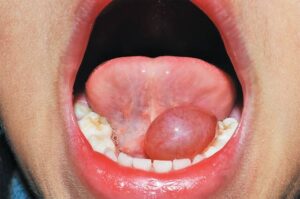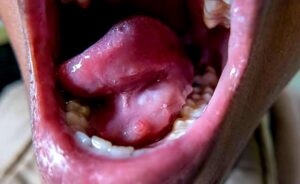
The ranula is a form of mucocele that specifically occurs in the floor of the mouth. The name is derived from the Latin word rana, which means frog, because the swelling may resemble a frog’s translucent underbelly. The term ranula also has been used to describe other similar swellings in the floor of the mouth including true salivary duct cysts, dermoid cysts, and cystic hygromas. Although the most common source of mucin spillage is sublingual gland, ranulas may also arise from the submandibular duct or from the minor salivary glands in the floor of the mouth.
Clinical Features :-
Ranulas usually appear as dome-shaped, fluctuant swellings in the floor of the mouth with a translucent blue color. Deeper ranulas are normal in color. This lesion, which is rare compared to the conventional mucocele, develops as a slowly enlarging painless mass located lateral to the midline of the floor of the mouth. This feature may help to distinguish ranulas from a midline dermoid cyst. Ranulas usually grow to larger sizes compared to ranulas that develop in other areas of the oral cavity.

The large ranulas may be several centimeters in diameter, filling the floor of the mouth, and elevating the tongue. A rare suprahyoid type of ranula, termed plunging or cervical ranula, occurs due to hernia- tion of spilled mucin through the mylohyoid mus- cle, producing swelling within the neck.
Histologic Features :-
The microscopic appearance is similar to that of the smaller mucoceles that occur in other locations. The spilled mucin elicits a granulation type of response that typically contains foamy histiocytes.
Treatment and Prognosis :-
The treatment and prognosis are also the same except that some operators prefer only to unroof the lesion rather than to excise it totally. Occasionally the lesion recurs. Some prefer initially to excise the entire sublingual gland.